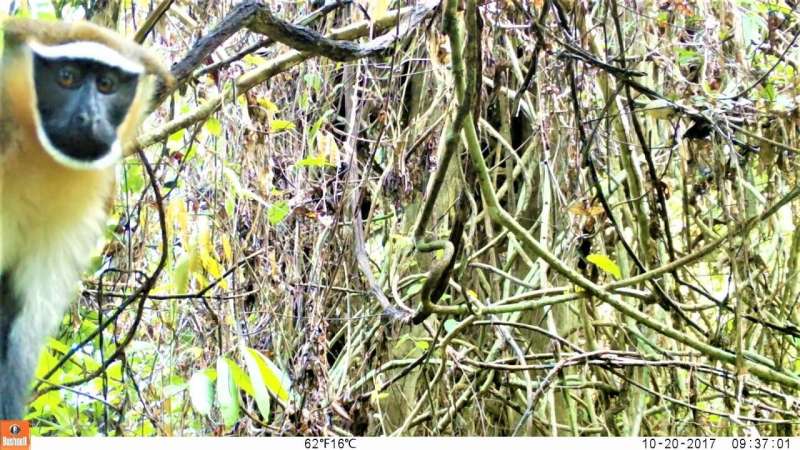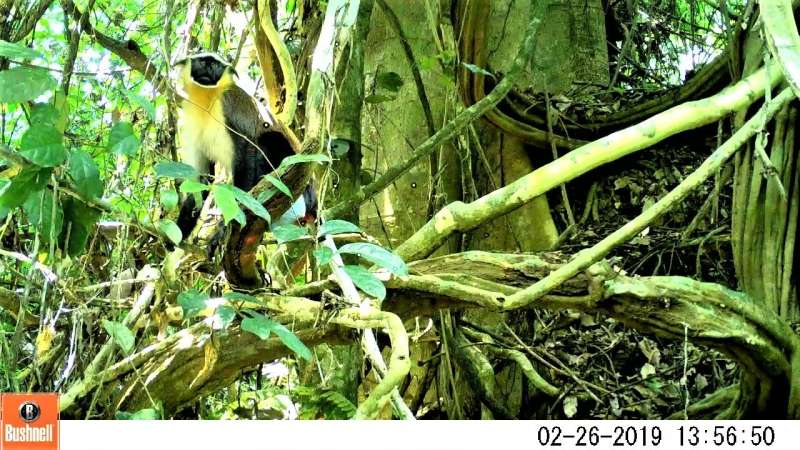Picture perfect: Camera traps find endangered dryas monkeys

The endangered dryas monkey (Cercopithecus dryas), endemic to the Democratic Republic of the Congo, is one of Africa's most mysterious primates. The discovery of the dryas monkey killed by a hunter in the buffer zone of Lomami National Park in 2014 has prompted field research of this small species (5-7 pounds). However, they are difficult to detect because they live in dense vegetation in secondary forest thickets.
Using non-invasive research and no-flash camera traps from 2014 to 2019, scientists from Florida Atlantic University in collaboration with researchers from the FZS-Lomami Project, Democratic Republic of the Congo, now have picture-perfect details on this elusive species. They have confirmed the occurrence of the dryas monkey at seven locations in both Lomami National Park and its buffer zone spanning a total area of 3,453 square kilometers, based on opportunistic reports provided by local village residents and park patrols.
Their findings, published in Oryx—The International Journal of Conservation, indicate that Lomami National Park and its buffer zone contain the greatest extent of the species' known range, and Lomami is the only national park with a confirmed population.
Although camera traps—a method for capturing wild animals on film when researchers are not present—are widely used to detect and survey cryptic species, the FAU scientists had to develop specific camera trap methods and placements to reliably detect the dryas monkeys.
Daniel Alempijevic, M.S., first author and a doctoral student at FAU, and Kate Detwiler, Ph.D., senior author and an associate professor in the Department of Anthropology in FAU's Dorothy F. Schmidt College of Arts and Letters, developed a species-specific multi-strata (0 to 29 meters) camera-trap technique to detect the species with a placement of three camera traps at each survey point, one each monitoring the ground, understory and canopy.
Alempijevic positioned the camera traps on game paths (0.2 to 0.5 meters above ground), shrubs and liana tangles (1.5 to 10 meters), and horizontal limbs (14.9 to 29 meters) forming pathways to adjacent tree crowns. He used a single rope technique to access the canopy, and a double-rope technique to move to the desired camera-trap location when needed. With the solicited information on the dryas monkeys from the residents of villages, he selected specific sites for camera-trap surveillance.
"We selected Bafundo Forest in the buffer zone for camera-trap surveillance, starting at the location where the first reported dryas monkey was killed by a hunter," said Detwiler. "We established the second survey site 40 kilometers west of Bafundo Village, at Camp Bartho in Lomami National Park after a ranger patrol team saw a dryas monkey there in 2014."
Camera traps accumulated 1,742 trap days on the ground, 2,821 trap days in the understory and 2,927 trap days in the canopy. Understory camera traps recorded 32 dryas monkey events, canopy camera traps detected a single event, and dryas monkeys were not detected by camera traps at ground level. The cameras that detected the species most frequently were those in the lower strata of the canopy and understory, at 2 to 10 meters above ground. At least 365 trap days are required to achieve a 95 percent detection probability, although dryas monkeys may be detected sooner in suitable habitats.

"Our camera-trap placements detected dryas monkeys almost exclusively in the understory across all surveys, regardless of canopy structure, which supports our hypothesis that the species appear to prefer structurally complex understories and forest edges," said Alempijevic. "Because our camera traps on the ground did not detect dryas monkeys, it seems unlikely that they travel on the ground. Only one camera trap in the canopy detected a dryas monkey, suggesting that they rarely travel in the upper canopy."
The researchers note that high heterozygosity and low inbreeding measures from genomic analysis of a hunter-killed dryas monkey (collected on Oct. 26, 2014) from Bafundo Forest suggest that it was a representative of a larger contiguous population.
"We recommend that researchers and conservationists working in the central basin of the Democratic Republic of the Congo mobilize local knowledge to identify other areas where the dryas monkey occurs and confirm any reports using our species-specific camera-trap placement technique," said Detwiler.
More information: Daniel Alempijevic et al, Using local knowledge and camera traps to investigate occurrence and habitat preference of an Endangered primate: the endemic dryas monkey in the Democratic Republic of the Congo, Oryx (2021). DOI: 10.1017/S0030605320000575
Journal information: Oryx
Provided by Florida Atlantic University
















